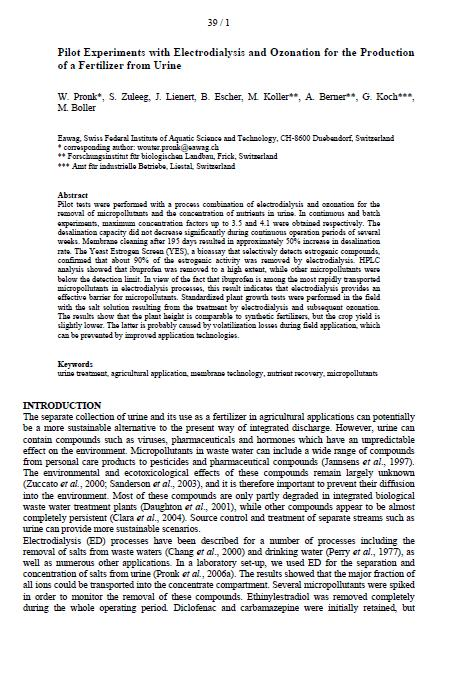Pilot Experiments with Electrodialysis and Ozonation for the Production of a Fertiliser from Urine
Pronk, W., Zuleeg, S., Lienert, J., Escher, B., Koller, M., Berner, A., Koch, G., Boller, M. (2007)

Published in: 2007
Author:
Pronk, W., Zuleeg, S., Lienert, J., Escher, B., Koller, M., Berner, A., Koch, G., Boller, M.
Uploaded by:
SuSanA secretariat
Partner profile:
common upload
3946 Views
9 Downloads
Content - Summary
Pilot tests were performed with a process combination of electrodialysis and ozonation for the removal of micropollutants and the concentration of nutrients in urine. In continuous and batch experiments, maximum concentration factors up to 3.5 and 4.1 were obtained, respectively. The desalination capacity did not decrease significantly during continuous operation periods of several weeks. Membrane cleaning after 195 days resulted in approximately 35% increase in desalination rate. The Yeast Estrogen Screen (YES), a bioassay that selectively detects oestrogenic compounds, confirmed that about 90% of the oestrogenic activity was removed by electrodialysis. HPLC analysis showed that ibuprofen was removed to a high extent, while other micropollutants were below the detection limit. In view of the fact that ibuprofen is among the most rapidly transported micropollutants in electrodialysis processes, this result indicates that electrodialysis provides an effective barrier for micropollutants. Standardised plant growth tests were performed in the field with the salt solution resulting from the treatment by electrodialysis and subsequent ozonation. The results show that the plant height is comparable to synthetic fertilisers, but the crop yield is slightly lower. The latter is probably caused by volatilisation losses during field application, which can be prevented by improved application technologies.
Additional information
Published in "Gewaesserschutz Wasser Abwasser", Vol. 206, pp. 39/1-9
Bibliographic information
Pronk, W., Zuleeg, S., Lienert, J., Escher, B., Koller, M., Berner, A., Koch, G., Boller, M. (2007). Pilot Experiments with Electrodialysis and Ozonation for the Production of a Fertiliser from Urine.
Filter tags
English Urine














